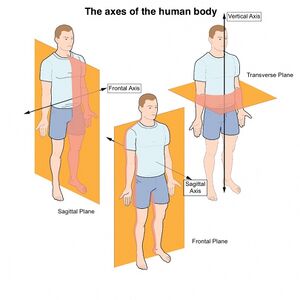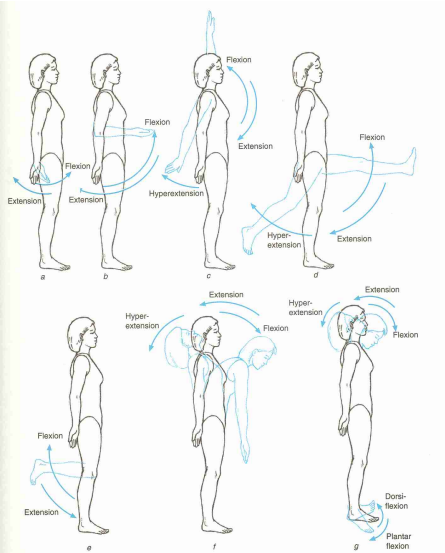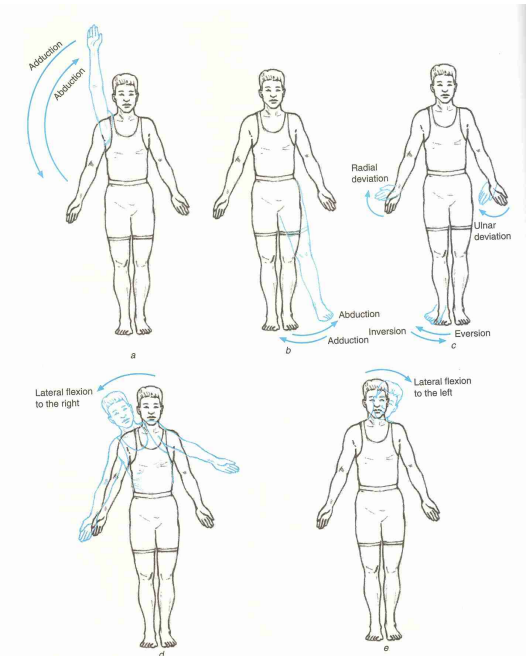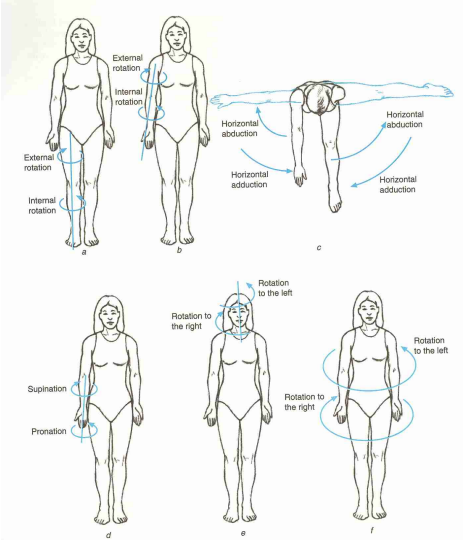Cardinal Planes and Axes of Movement: Difference between revisions
Evan Thomas (talk | contribs) mNo edit summary |
Kim Jackson (talk | contribs) m (Removed protection from "Cardinal Planes and Axes of Movement": This is no longer a Plus course page) |
||
| (25 intermediate revisions by 11 users not shown) | |||
| Line 4: | Line 4: | ||
'''Top Contributors''' - {{Special:Contributors/{{FULLPAGENAME}}}} | '''Top Contributors''' - {{Special:Contributors/{{FULLPAGENAME}}}} | ||
</div> | </div> | ||
== The Anatomical Position == | == The Anatomical Position == | ||
= | The anatomical position is the point of reference for all movements. In the anatomical position the body is upright with the arms by the sides, shoulder in neutral rotation, palms facing forward, elbows and fingers extended and the thumbs in an adducted position with the thumb pads facing forward. The lower limbs are straight, the feet slightly apart with the second toe facing forward. <ref name=":0">Cameron MH, Monroe LG. 2008. Physical Rehabilitation: Evidence-Based Examination, Evaluation, and Intervention. Elsevier</ref> | ||
{| width="40%" cellspacing="1" cellpadding="1" border="0" align="right | The standard anatomical position provides an understandable and accurate way of describing human anatomy, physiology and joint planes and axes. It is also the zero position when measuring range of motion.<ref name=":0" /> Watch the 2 minute video (R) to get a grasp of the topic. | ||
{| class="FCK__ShowTableBorders" width="40%" cellspacing="1" cellpadding="1" border="0" align="right" | |||
|- | |- | ||
|{{#ev:youtube|aDxfe5Ny6zM|300}} <ref>Tim Huffines. Anatomical Position and Cardinal Planes. Available from: http://www.youtube.com/watch?v=aDxfe5Ny6zM [last accessed 22/02/13]</ref> | |||
| {{#ev:youtube|aDxfe5Ny6zM|300}} <ref>Tim Huffines. Anatomical Position and Cardinal Planes. Available from: http://www.youtube.com/watch?v=aDxfe5Ny6zM [last accessed 22/02/13]</ref> | |||
|} | |} | ||
Three basic reference planes are used in anatomy | == Planes == | ||
[[File:Axes of the human body.jpg|thumb]] | |||
Three basic reference planes are used in anatomy | |||
#A '''sagittal plane,''' also known as the longitudinal plane, is perpendicular to the ground and divides the body into left and right. The ''midsagittal'' or ''median plane'' is in the midline i.e. it would pass through the midline structures (e.g. navel or spine), and all other sagittal planes (also referred to as ''parasagittal planes'') are parallel to it. ''Median'' can also refer to the midsagittal plane of other structures, such as a digit. | |||
#A '''coronal''' or frontal plane is perpendicular to the ground and divides the body into dorsal (posterior or back) and ventral (anterior or front) portions. | |||
#A '''transverse plane''', also known as an ''axial plane'' or cross-section, divides the body into cranial (head) and caudal (tail) portions. It is parallel to the ground, which (in humans) separates the superior from the inferior, or put another way, the head from the feet.<br> | |||
When describing anatomical motion, these planes describe the axis along which an action is performed. So by moving through the transverse plane, movement travels from head to toe. For example, if a person jumped directly up and then down, their body would be moving through the transverse plane in the coronal and sagittal planes. | |||
When describing anatomical motion, these planes describe the axis along which an action is performed. So by moving through the transverse plane, movement travels from head to toe. For example, if a person jumped directly up and then down, their body would be moving through the transverse plane in the coronal and sagittal planes. | |||
== Axes == | == Axes == | ||
An axis is a straight line around which an object rotates. Movement at the joint | An axis is a straight line around which an object rotates. Movement at the joint takes place in a plane about an axis. There are three axes of rotation. | ||
* | *Sagittal axis - passes horizontally from posterior to anterior and is formed by the intersection of the sagittal and transverse planes. | ||
*Frontal axis - passes horizontally from left to right and is formed by the intersection of the frontal and transverse planes. | *Frontal axis - passes horizontally from left to right and is formed by the intersection of the frontal and transverse planes. | ||
*Vertical axis - passes vertically from inferior to superior and is formed by the intersection of the | *Vertical axis - passes vertically from inferior to superior and is formed by the intersection of the sagittal and frontal planes. | ||
== Describing Movement | == Describing Movement == | ||
{{#ev:youtube| | {{#ev:youtube|iP7fpHuVaiA|300|center}}<ref>Planes & Axes of Motion. Published 2012. Available from: https://www.youtube.com/watch?v=iP7fpHuVaiA. (last accessed 28 November 2019) </ref> | ||
'''Extension''' occurs when the angle between two adjacent segments in the body increases as the ventral surfaces of the segments move away from each other and occurs in a sagittal | '''Extension''' occurs when the angle between two adjacent segments in the body increases as the ventral surfaces of the segments move away from each other and occurs in a sagittal plane about a frontal axis. An exception is extension of the thumb, which takes place in a frontal plane about a sagittal axis. | ||
'''Flexion''' occurs when the angle between two adjacent segments in the body decreases as the ventral surfaces of the segments approximate each other and occurs in a sagittal plane about a frontal axis. An exception is flexion of the thumb, which takes place in a frontal plane about a sagittal axis. | '''Flexion''' occurs when the angle between two adjacent segments in the body decreases as the ventral surfaces of the segments approximate each other and occurs in a sagittal plane about a frontal axis. An exception is flexion of the thumb, which takes place in a frontal plane about a sagittal axis. | ||
[[Image:Movement in the sagital plane about the frontal axis.png|frame|center|Movement in the | [[Image:Movement in the sagital plane about the frontal axis.png|frame|center|Movement in the sagittal plane about the frontal axis]]<br> | ||
'''Abduction/Adduction''' These are movements in the frontal plane about the | '''Abduction/Adduction''' These are movements in the frontal plane about the sagittal axis and involve moving the body part away or towards an imaginary centre line. Abduction is taking the body part away from the central line and adduction is moving it towards. Adduction can also be moving the body part across the centre line and to the other side of the body, shown in the hip abduction image below. Amongst the joints capable of abduction and adduction are the shoulder and hip. Other abduction and adduction movements include the fingers. If you splay your fingers and move them apart, this is abduction as they are moving away from the centre position. When you bring the fingers back together, this is adduction, as you are adding them back to the centre line<br> | ||
[[Image:Movement in the frontal plane about the sagital axis.png|frame|center|Movement in the frontal plane about the | [[Image:Movement in the frontal plane about the sagital axis.png|frame|center|Movement in the frontal plane about the sagittal axis]] | ||
<br> '''Rotation ''' | <br> '''Rotation '''movements are in the transverse plane and include any twisting motion. Joints which permit rotation include the shoulder and hip. These are both ball and socket joints. We can also rotate our necks and backs due to a series of smaller joints, including the atlantoaxial joint which is a pivot joint in the neck between the first two vertebrae (C1 and C2). Rotation of the hip and shoulder can be broken down into internal or external rotation (also sometimes known as medial and lateral rotation respectively). | ||
[[Image:Movement in the transverse (horizontal) plane about the vertical axis.png|frame|center|Movement in the transverse (horizontal) plane about the vertical axis]] | [[Image:Movement in the transverse (horizontal) plane about the vertical axis.png|frame|center|Movement in the transverse (horizontal) plane about the vertical axis]] | ||
== | == Summary == | ||
{| cellpadding="5" style="border: 1px #ccc solid;" | |||
|- style="background-color: #E5E5E5;" | |||
| width="20%" style="border: 1px #ccc solid;" | '''''Plane''''' | |||
| style="border: 1px #ccc solid; spacing: 5px;" | '''''Description''''' | |||
|- | |- | ||
| | | Coronal / Frontal / Lateral | ||
| | | Bisects the body laterally from side to side, dividing it into front and back halves. Abduction and Adduction movements occur in this plane. | ||
|- | |||
| Sagittal / Antero-posterior | |||
| Bisects the body from front to back, dividing it into left and right halves. Flexion and Extension movements usually occur in this plane. | |||
|- | |||
| Transverse / Horizontal | |||
| Divides the body horizontally into Superior and Inferior halves. Rotational movements usually occur in this plane. | |||
|} | |} | ||
== References == | == References == | ||
<references /> | |||
<references /> | [[Category:Open_Physio]] | ||
[[Category:Rehabilitation Foundations]] | |||
[[Category: | [[Category:Biomechanics]] | ||
Latest revision as of 09:08, 24 July 2023
Original Editor - The Open Physio project
Top Contributors - Admin, Rachael Lowe, Tarina van der Stockt, Kim Jackson, Lucinda hampton, Laura Ritchie, Evan Thomas, Simisola Ajeyalemi, Wanda van Niekerk, Tony Lowe, Scott Buxton, Kai A. Sigel, Claire Knott, Jess Bell and Olajumoke Ogunleye
The Anatomical Position[edit | edit source]
The anatomical position is the point of reference for all movements. In the anatomical position the body is upright with the arms by the sides, shoulder in neutral rotation, palms facing forward, elbows and fingers extended and the thumbs in an adducted position with the thumb pads facing forward. The lower limbs are straight, the feet slightly apart with the second toe facing forward. [1]
The standard anatomical position provides an understandable and accurate way of describing human anatomy, physiology and joint planes and axes. It is also the zero position when measuring range of motion.[1] Watch the 2 minute video (R) to get a grasp of the topic.
| [2] |
Planes[edit | edit source]
Three basic reference planes are used in anatomy
- A sagittal plane, also known as the longitudinal plane, is perpendicular to the ground and divides the body into left and right. The midsagittal or median plane is in the midline i.e. it would pass through the midline structures (e.g. navel or spine), and all other sagittal planes (also referred to as parasagittal planes) are parallel to it. Median can also refer to the midsagittal plane of other structures, such as a digit.
- A coronal or frontal plane is perpendicular to the ground and divides the body into dorsal (posterior or back) and ventral (anterior or front) portions.
- A transverse plane, also known as an axial plane or cross-section, divides the body into cranial (head) and caudal (tail) portions. It is parallel to the ground, which (in humans) separates the superior from the inferior, or put another way, the head from the feet.
When describing anatomical motion, these planes describe the axis along which an action is performed. So by moving through the transverse plane, movement travels from head to toe. For example, if a person jumped directly up and then down, their body would be moving through the transverse plane in the coronal and sagittal planes.
Axes[edit | edit source]
An axis is a straight line around which an object rotates. Movement at the joint takes place in a plane about an axis. There are three axes of rotation.
- Sagittal axis - passes horizontally from posterior to anterior and is formed by the intersection of the sagittal and transverse planes.
- Frontal axis - passes horizontally from left to right and is formed by the intersection of the frontal and transverse planes.
- Vertical axis - passes vertically from inferior to superior and is formed by the intersection of the sagittal and frontal planes.
Describing Movement[edit | edit source]
Extension occurs when the angle between two adjacent segments in the body increases as the ventral surfaces of the segments move away from each other and occurs in a sagittal plane about a frontal axis. An exception is extension of the thumb, which takes place in a frontal plane about a sagittal axis.
Flexion occurs when the angle between two adjacent segments in the body decreases as the ventral surfaces of the segments approximate each other and occurs in a sagittal plane about a frontal axis. An exception is flexion of the thumb, which takes place in a frontal plane about a sagittal axis.
Abduction/Adduction These are movements in the frontal plane about the sagittal axis and involve moving the body part away or towards an imaginary centre line. Abduction is taking the body part away from the central line and adduction is moving it towards. Adduction can also be moving the body part across the centre line and to the other side of the body, shown in the hip abduction image below. Amongst the joints capable of abduction and adduction are the shoulder and hip. Other abduction and adduction movements include the fingers. If you splay your fingers and move them apart, this is abduction as they are moving away from the centre position. When you bring the fingers back together, this is adduction, as you are adding them back to the centre line
Rotation movements are in the transverse plane and include any twisting motion. Joints which permit rotation include the shoulder and hip. These are both ball and socket joints. We can also rotate our necks and backs due to a series of smaller joints, including the atlantoaxial joint which is a pivot joint in the neck between the first two vertebrae (C1 and C2). Rotation of the hip and shoulder can be broken down into internal or external rotation (also sometimes known as medial and lateral rotation respectively).
Summary[edit | edit source]
| Plane | Description |
| Coronal / Frontal / Lateral | Bisects the body laterally from side to side, dividing it into front and back halves. Abduction and Adduction movements occur in this plane. |
| Sagittal / Antero-posterior | Bisects the body from front to back, dividing it into left and right halves. Flexion and Extension movements usually occur in this plane. |
| Transverse / Horizontal | Divides the body horizontally into Superior and Inferior halves. Rotational movements usually occur in this plane. |
References[edit | edit source]
- ↑ 1.0 1.1 Cameron MH, Monroe LG. 2008. Physical Rehabilitation: Evidence-Based Examination, Evaluation, and Intervention. Elsevier
- ↑ Tim Huffines. Anatomical Position and Cardinal Planes. Available from: http://www.youtube.com/watch?v=aDxfe5Ny6zM [last accessed 22/02/13]
- ↑ Planes & Axes of Motion. Published 2012. Available from: https://www.youtube.com/watch?v=iP7fpHuVaiA. (last accessed 28 November 2019)










